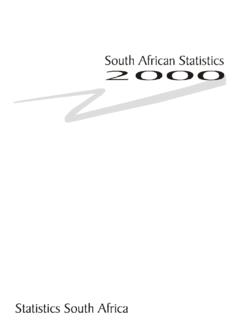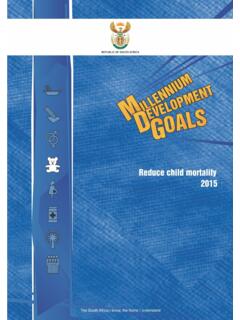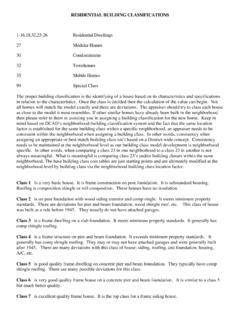Transcription of South African Standard Classification of Occupations (SASCO)
1 South African Standard Classification of Occupations (SASCO) Draft October 2003 2 CONTENTS Page Preface .. 3 Introduction .. 3 Main objectives .. 4 International comparability .. 4 Definitions .. 5 Structure and format .. 8 Key to Classification codes .. 9 Description of major and sub-major groups .. Major group 1: Legislators, senior officials and managers .. 10 Major group 2: Professionals .. 11 Major group 3: Technicians and associate professionals .. 13 Major group 4: Clerks .. 15 Major group 5: Service workers and shop and market sales workers.
2 16 Major group 6: Skilled agricultural and fishery workers .. 17 Major group 7: Craft and related trades workers .. 18 Major group 8: Plant and machine operators and assemblers .. 20 Major group 9: Elementary Occupations .. 22 Major group 0: Armed forces, occup ations unspecified and not else- where classified and not economically active persons . 23 Summary of major, sub major, minor and unit group titles .. 24 Description of detailed Occupations : Major group 1: Legislators, senior officials and managers .. 57 Major group 2: Professionals .. 72 Major group 3: Technicians and associate professionals.
3 112 3 Major group 4: Clerks .. 136 Major group 5: Service workers and shop and market sales workers .. 146 Major group 6: Skilled agricultural and fishery workers .. 152 Major group 7: Craft and related trades workers .. 163 Major group 8: Plant and machine operators and assemblers .. 228 Major group 9: Elementary Occupations .. 263 Major group 0: Armed forces, occup ations unspecified and not else- where classified and not economically active persons . 272 PREFACE The purpose of the South African Standard Classification of Occupations (SASCO) publication is to provide a national framework for the identification of Occupations and will provide a basis for international occupational comparability.
4 This publication is the result of collaborative work between Stats SA, several government departments, private organisations and other stakeholders. It was necessitated by structural changes in the South African labour market. SASCO is based on the United Nations International Standard Classification of Occupations (ISCO - 88) and will form the basis for all future occupational Classification work and revised as and when necessitated by local or international circumstances. Stats SA wishes to express its thanks to all those who directly or indirectly contributed to the completion of the SASCO.
5 INTRODUCTION The South African Standard Classification of Occupations (SASCO) serves as a systematic basis for the Classification of data on Occupations , obtained by means inter alia, the 2001 Population Census and the Labour Force Survey (LFS). 4 Occupations contained in this Classification manual cover Occupations in both the formal and the informal business sectors so to as fully reflect Occupations in the South African labour market. MAIN OBJECTIVES The main objectives are: - to provide a framework for the development of national occupational classifications.
6 - to provide a framework for analysing Occupations in the South African labour market. - to take account of development and changes within the various Occupations . - to provide sound occupational statistics which can be comparable to those produced by other agencies according to the ISCO. INTERNATIONAL COMPARABILITY This edition of the SASCO was developed using a similar conceptual basis to that of the United Nations International Standard Classification of Occupations (ISCO-88). The ISCO was developed by the International Labour Office in Geneva with the latest version being produced in 1988.
7 5 The main aims of the ISCO are to provide a basis for international comparisons of occupational statistics between countries and to provide a conceptual model for the development of national occupational classifications. ISCO-88 consists of nine major groups, 28 sub-major groups, 116 minor groups and 390 unit groups. It includes a separate major group 0 for Armed Forces. In common with the ISCO-88, the SASCO, also incorporates the sub-major group as a level of aggregation between the major and minor groups. DEFINITIONS Definitions relate to this publication of the SASCO - Job A job is defined as a set of tasks and duties to be performed by one person.
8 Major g roup A major group is denoted by a one-digit code, and is the broadest level of the Classification . There are nine major groups. Minor group A minor group is denoted by a three-digit code, and is a sub-division of a sub-major group. There are 153 minor groups. Occupation An occupation is defined as a set of jobs with similar sets of tasks. Skill A skill is defined as the ability to carry out the duties and tasks of a specific job. Skill level A skill level is defined as a function of the range and complexity of the set of tasks or duties involved. A skill is measured by means of formal education and experience.
9 Four skill levels are defined - First skill level The ISCO identified the first skill level as primary education, which generally begins at the age of five, six or seven and which lasts about five years. According to South African conditions the first skill level entails persons who received primary education which generally begins at the 6 age of six or seven and lasts about seven years. However this skill level might also include persons without any formal primary education. Second skill level The ISCO defined the second skill level as the first and second stages of secondary education.
10 The first stage begins at the age of 11 or 12 and lasts about three years, while the second stage begins at the age of 14 or 15 and also lasts about three years. A period of on the job training and experience may be necessary, sometimes formalized in apprenticeships. This period may supplement the formal training or replace it partly or, in some cases wholly. According to South African conditions the second skill level entails secondary education which begins at the age of 13 or 14 and lasts about five years. A period of on-the-job-training and experience may be necessary.















